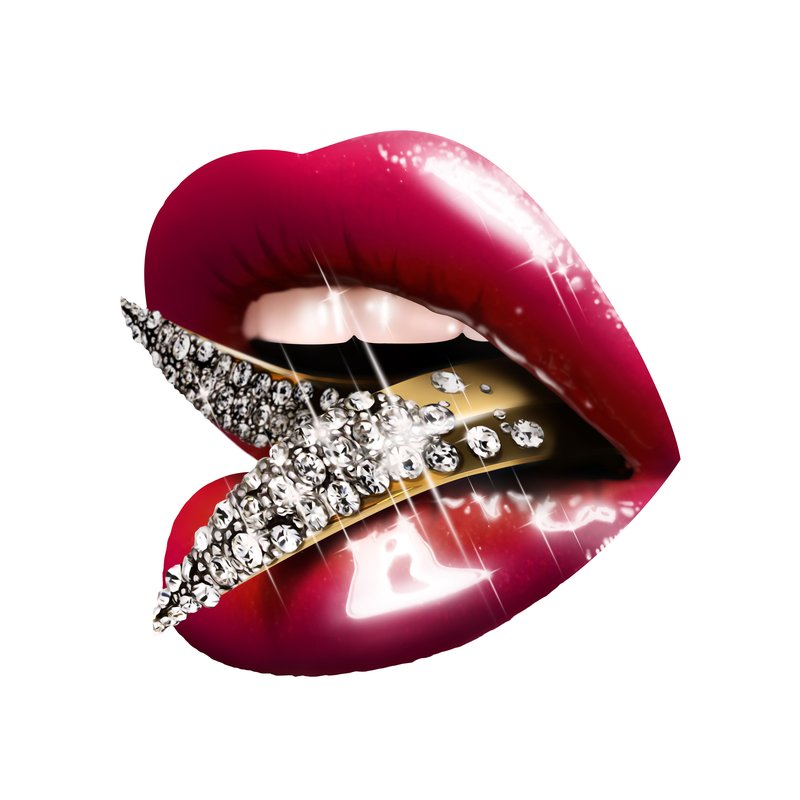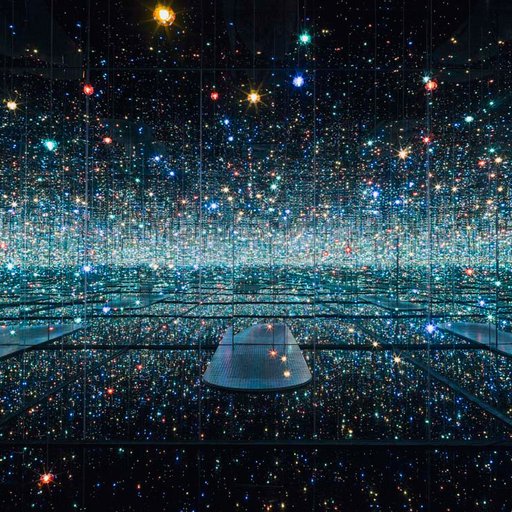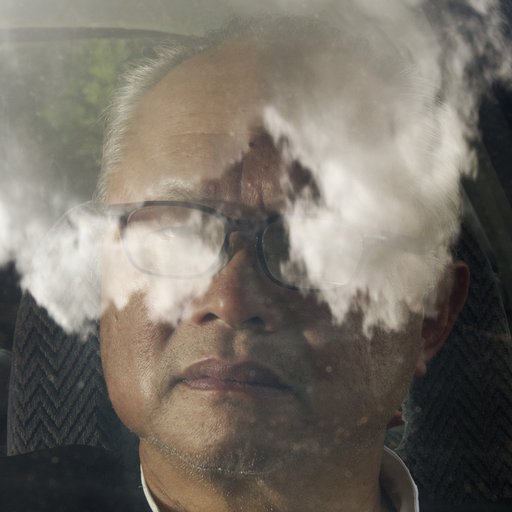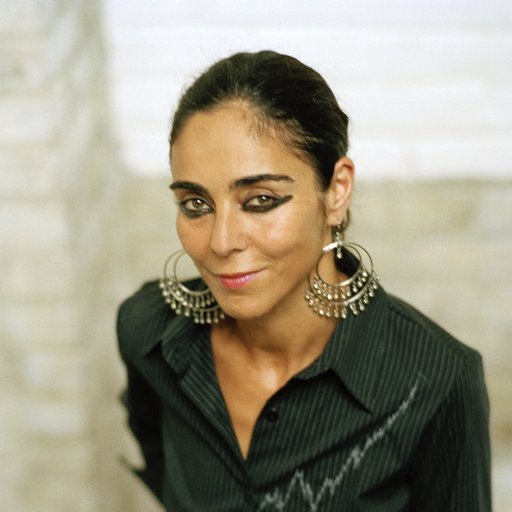In the animated video piece Swell , figures in silhouette—save for their fluorescent construction vests—labor away before a bright patterned background that swirls and shimmers despite a darker subtext. Based on Hudson River painter Thomas Cole's series of paintings that represent the industrial revolution, Swell —by artist Chris Doyle—references a story of both "progress" and environmental destruction. We see rivers become water slides and landscapes become Modernist architecture, each scene collaged and layered over one another.
Chris Doyle,
Swell,
2017, 4k digital animation, 10:13.
Doyle's animated landscapes have become part of one of our most iconic built landscapes: In 2014, the artist transformed the concrete jungle of Times Square into a flourishing canyon unfolding over almost a dozen screens. The project,
Bright Canyon
, screened every night for the month of July. The artist has also exhibited his work all over the world at institutions like the Brooklyn Museum, Queens Museum, P.S.1, MassMoCA, and The Aldrich Contemporary Art Museum.
In Doyle's recent collaboration with Artspace and 21c Museum Hotel , the artist has transformed Swell into a deconstructed, condensed, and two-dimensional object—a scarf. Here, Artspace speaks with the artist soon after his move to Mexico City about the scarf edition, the influence of geographic history, the new direction for his current project, and society's shift towards a virtual culture.
You’re in Mexico City right now… What are you doing there?
I wanted to come down here and see what it was like. I had deadlines but they were mostly not travel deadlines. So I’ve been able to stay in one place for a couple of months, which is fantastic. It's incredible here!
Is this your first time in the city?
We did a 10-day reconnaissance to check it out. Between climate, food, the fact that it's really cheap, and there's so much art and color—it's been great.
Is there any evidence of the earthquake still?
It's interesting: when we first got here they were still cleaning up; there were some roads ripped up. But around the neighborhoods of Condesa and Roma there are a lot of buildings that look normal on the outside but are empty on the inside; they've been condemned and need to be taken down, but I think that process is going to be a long one. It's mostly buildings that were built in the '70s out of concrete. They were basically built with paper clips instead of rebar. There's a particular vintage of building that's been empty.
Do you see any parallels between the landscape you're in now and your work? You’re in a kind of post-semi-apocalyptic scenario!
[Laughs.] You know, I've been teaching myself lately to not get taken into what I think of now as “disaster porn.” It really is hard for me because when I see that stuff, my first thought is to document it; I have this pull to it. But you're absolutely right, you get to a corner and there's a building where only half of it is still there and you see into the rooms and everything inside—and the rest is crumbled. That is it. That's my thing. But there's a whole other world here that’s pulled me in too. There are a lot of artifacts from the ancient cultures that are really powerful in this other way. I've been thinking a lot about those. I think I'm going to be inspired for a good long time by what I’ve seen in the past six months. But right now I’m transitioning into a new project and the change of scene has been really great.
Can you tell me a little bit about this new project that you're working on?
Well let me preface it by telling you about the old project. It was inspired by Thomas Cole's The Course of Empire series of five paintings. I made a lot of landscape-based animations that traced the transition that Cole went through from agrarian culture to industrial culture. Now I want to move away from landscape a little bit just as a break, but I’m continuing to think about this idea of an industrialized culture transitioning to a post-industrial digital culture—and all of the socio-economic implications of that. So this project will relate to Charlie Chaplin’s Modern Times , which basically treats the worker in the factory as a cog, and is about the discomfort with the transition into industrialized culture. I’m updating it to apply to the transition out of industrialized culture and into the digital world. So I’m making these animations that are part machines and part strange artifacts.
Mexico has been really inspiring. When you walk around the National Museum of Anthropology, for instance, you realize you don't really have any idea what the objects you’re looking at really were. Were they everyday objects? Were they used in religious rituals? What exactly were they? For all we know they could have been toys. So much of their power comes from what we project onto them I think. I've thought for a long time about the way they might move, and how to animate them. So all of that eventually got folded up into this new project about the updating of modern times.
Your scarf, which is based on the older project you just described, was produced in collaboration with 21c Museum Hotel, and you've showed your work with them before. What can you tell me about your relationship with them?
They are great patrons. I've worked with them before, and they have a lot of my work in their collection. As a model for a future museum they're amazing because they sustain themselves; they don't have to do that thing that museum boards have to do, which is: you get your benefit together and as soon as you finish your benefit you start working on next year's benefit. 21c has been so great about expanding the collection and buying work of emerging and established artists. They are a great modern patron and they collect deep rather than wide. As an artist, I love that.
Can you tell me about the scarf edition?
I have done this thing for a while now where I try to transform the feeling you get when watching my animations into a two-dimensional non-durational experience—a parallel experience that happens in space. So I would unfold the frames into a design, and you’d see the whole animation on a two-dimensional plane. For you guys, I took Swell , the final piece of the Course of Empire series, and unfolded it so that you see a lot of the frames of the animation all at once, at different scales. A lot of the frames that are in the animation have to do with patterning to begin with, so it felt natural to deploy the frames into a pattern as well. I've always been attracted to pattern. Seeing pattern is a change in perspective. In a way I think of making a two-dimensional scarf design as a change in perspective.
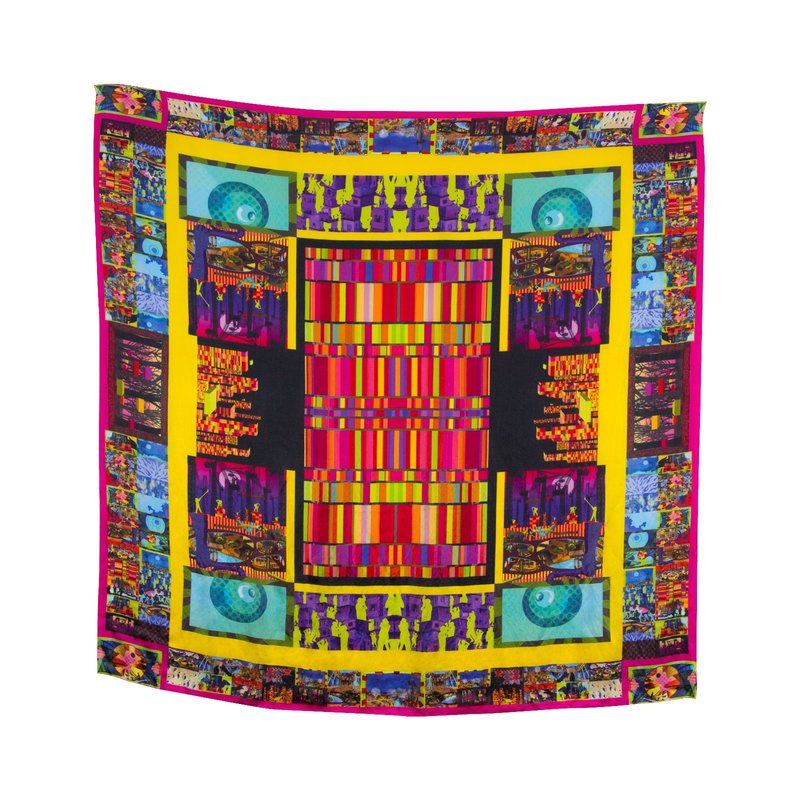 Untitled (Alice)
, 2018 is available on Artspace for $195
Untitled (Alice)
, 2018 is available on Artspace for $195
There are indeed a lot of patterns in your works. Where do they come from? Do you design them or are they appropriated?
In Waste Generation , my interest started out with the dollar bill, which led to William Morris wallpaper and a whole set of pattern themes. With Swell , I was thinking about DNA and units of patterning. I think a lot of people are saying now that it looks like video games. It's funny because when you start with a unit that's a pixel or a little rectangle, it just so happens that it ends up looking like it's related to video games—but it wasn't actually in my head at the time. There are a lot of borders in that piece, and I had been thinking a lot about Persian miniatures and the way that borders are used in medieval manuscripts and illustrations.
So much of your work has to do with the destruction of the environment. Do you consider yourself an activist?
That's a really interesting question. In the sense that I'm active in making things that are intended to enlighten or amplify a particular issue, yes. But I look at a lot of my friends and think, "Oh my gosh, you guys are amazing in that you have so much energy to do all of your work and be active." I wish I was a little more active than I am. I try to not be didactic in making work but instead, I hold up a mirror and ask provocative questions as a way to get people think about things. I'm also really interested in the trojan horse model, which is to draw people in who don't necessarily agree with my views—with the use of seductive colors and a lush world—and then open their eyes to the dark reality that's at the core of the work.
Right, there's a deep sense of loss and of longing in your work—longing for this lost landscape. And that's something that everyone can relate to, yet for many people maybe they haven't related those feelings of loss yet to the landscape and to the environment in the same way that you have.
I think that's right. People are really excited about their smartphones without thinking about what it takes to get them there—both in terms of resources and labor. Not seeing the thing that you're excited about as being part of a larger economic system or a larger environmental system is something that I think is super common. I think a lot of what I do —not in a bash-you over-the-head way, but in a subtle way—is to amplify those connections.
RELATED ARTICLES:
21c's Co-Founder Steve Wilson on Inventing the Museum Hotel
Artist Frances Goodman on Assertive Women and Wedding Culture












